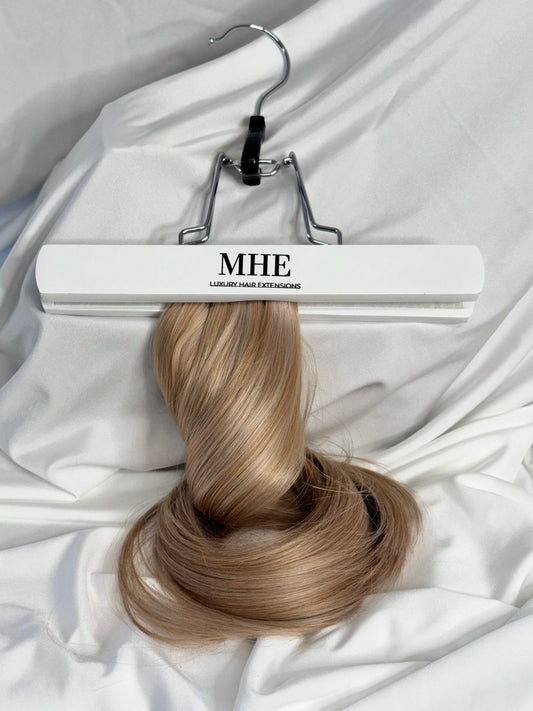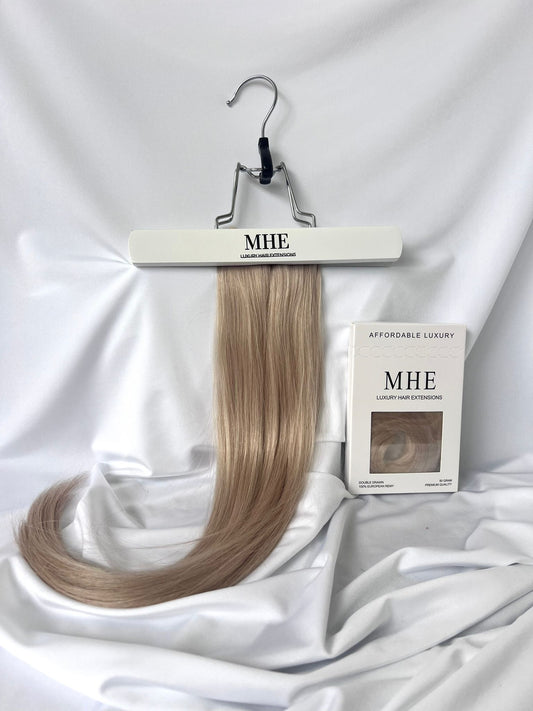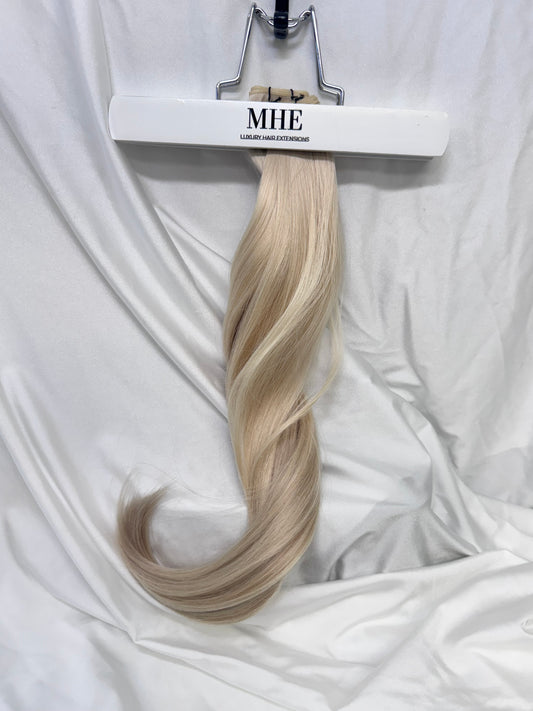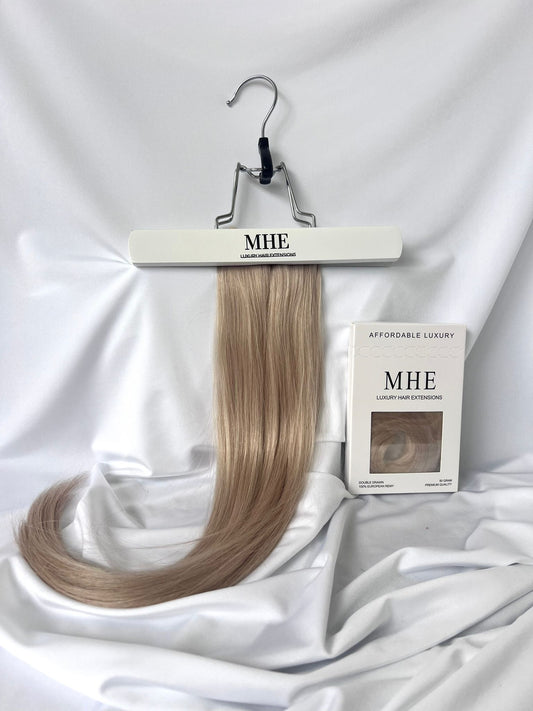If your natural hair is on the thinner side, choosing the right type of hair extensions can feel overwhelming, especially when every brand claims to have the “perfect” solution.
In this guide, we’ll break down every extension method that can work for fine or thin hair, explain why some techniques, like tape-in extensions, are better than others, and share tips on application, maintenance, and removal.
By the end, you’ll know exactly which extension type fits your lifestyle, budget, and hair goals.
Why Thin Hair Needs a Gentler Approach
Unlike medium or coarse strands, fine hair has a smaller diameter and a more fragile cuticle layer. This means that excess weight, tight attachment points, or frequent friction can cause snapping, shedding, or even traction alopecia.
Understanding these vulnerabilities will help you avoid unnecessary damage and keep your natural hair thriving underneath your extensions.
Fragile Cuticle Structure
Each hair shaft is protected by overlapping scales known as the cuticle. In fine hair, these scales are fewer and thinner, making the shaft more susceptible to chipping and splitting. Heavy extensions can accelerate this process by putting excessive tension on your hair, so choosing low-density wefts is crucial.
Visible Scalp Concerns
People with thin hair often worry about tracks or bonds showing through. Selecting flat, discreet attachment points, like slim tape tabs or invisible bonds can help maintain a natural appearance even in bright lighting.
Lower Tension Tolerance
Because the follicles have less support from neighboring strands, they can’t handle as much tension. Methods that rely on tightly sewn braids or bulky metal rings may lead to soreness or hair loss over time and should be avoided with thin hair.
Criteria for Selecting Extensions for Fine or Thin Hair
Before we explore each hair extension type in detail, it’s helpful to have a checklist of things to look out for when choosing the right type for your thin hair. Keep these factors in mind as you weigh your options.
1. Weight-to-Strand Ratio
The extension should never outweigh the section of natural hair it is attached to. Look for phrases like “extra-lightweight” in product descriptions.
2. Attachment Surface Area
A wider bond distributes weight more evenly, reducing stress on individual strands. Tape-ins and tiny keratin micro bonds are great for this.
3. Reusability & Maintenance Schedule
How often are you willing to visit the salon? Some systems (like tape-ins) require repositioning every 6-8 weeks as your natural hair grows out. Others (like clip-ins) you can pop on and off at home in seconds.
4. Daily Styling Habits
If you heat-style a lot, keratin bonds and hand-tied wefts handle thermal tools well. If you prefer air-drying then clip-ins are a good choice.
5. Budget & Longevity
While clip-ins & tapes often have the lowest long-term cost, ultimate wefts and keratin bonds last longer (6-12 months) but can come with a higher upfront price tag.
Clip-In Extensions: The Five-Minute Volume Boost
Clip-ins are the gateway extensions for many, but should you use them on thin hair? If you pick the right weight and follow proper application techniques, clip-ins can work with thin hair.
Lightweight Clip-ins Designed for Fine Hair
Standard clip-in sets can carry up to 200g of hair which can be too heavy for delicate strands. Clip-ins that are better suited for “fine hair” range from 80-120 g spread across more pieces. This allows you to distribute volume without overloading any single section.
It’s important to put in clip-in hair extensions properly to avoid unnecessary pulling or visibility of the clips.
Pros of Clip-Ins for Thin Hair
- No commitment - you can remove them before sleeping, swimming, or workouts or only put them in on special occasions.
- They are lower cost compared to salon-installed methods as you can install them yourself.
- You can change colours without the chemical damage.
Cons & Cautions
- Sleeping in clip-ins should be avoided as it can lead to tangling and breakage from the friction caused between your head and the pillow.
- Incorrect placement of the clips can reveal tracks on thin hair making them slightly harder to blend in.
- Daily clipping and unclipping may cause minor tension if handled roughly.
Tape-In Extensions: Seamless, Flat, and Lightweight
Tape-ins are often praised as the best semi-permanent option for fine hair, and for good reason. Each “tape” uses two adhesive strips that lie perfectly flat against the head, distributing weight evenly and creating a fairly seamless look.
How Tape-Ins Work
A stylist places a thin slice of your own hair between two pre-taped wefts, securing the adhesive with gentle pressure or a flat iron on low heat. The result is a bond so flat you can run your fingers over it with hardly any detection.
Ideal Weight & Density
For thin hair, choose 25-50g packs and look out for specific labels such as “single drawn” or “fine hair option.” Overloading your head will create a ledge where the weft starts, making styling tricky. Something like our purest blonde tape in extension is a popular choice for people with thin hair.
Longevity & Reinstallation
With tape extensions, you can expect 6-8 weeks of wear before the tapes need lifting and fresh adhesive. This is due to your natural hair growing out with the tapes, so readjustment is required to ensure they stay seamless. Quality hair can be reused a few times before needing to replace the extensions.
Benefits of Tape-Ins for Fine Hair
- Ultra-flat finish ideal for thin hair.
- Quick installation (around 45-90 minutes).
- Minimal discomfort when properly applied.
Tape-In Cons
- Cannot be applied too close to the hairline.
- Adhesive may weaken with heavy oil or silicone-based products.
- Requires professional installation.
Keratin Bond Extensions: Customised Coverage
While keratin bonds are better suited for thicker hair, they aren’t automatically off-limits for thin hair - the secret is in the size of each bond.
Micro or mini tips weigh just a couple of grams each, allowing stylists to tailor placement and density precisely where you need volume.
Application Fundamentals
A fusion tool melts the keratin tip at a low temperature, fusing it with a section of your natural hair. The bond is rolled between the fingers into a rice-grain shape. With a skilled stylist, the bond remains slim and comfortable.
Pros of keratin bonds
- 360-degree movement
- Bonds can last up to 6 months with proper care.
- Virtually invisible when colour-matched.
Cons of keratin bonds on thin hair
- Removal requires an acetone-based solution; improper technique can snag fine hair.
- Heat application may worry some clients (though temperatures are controlled).
- Higher labor cost due to time-intensive install.
Frequently Asked Questions About Thin Hair Extensions
Can hair extensions cause permanent damage to thin hair?
When installed and maintained correctly, extensions should not cause irreversible harm. The key is selecting a gentle method and following aftercare religiously. Overlooking maintenance schedules, using heavy products near the bonds, or tugging during removal are the biggest culprits of damage.
How many grams of hair do I need?
For a subtle boost, 100g is plenty. For a full head of hair, you might need 200g, but exceeding that risks overloading your strands.
What’s the safest sleeping routine?
Tie your hair in a loose, low braid or ponytail, use a silk pillowcase, and never go to bed with wet hair. For clip-ins remove them before sleeping altogether and store them neatly in a silk bag.
How often should I wash my hair with extensions?
Every 2-3 days is standard. Over-washing your extensions strips away natural oils, making both your hair and extensions dry. Use sulfate-free shampoo and focus on cleansing the scalp.
Final Thoughts: Your Path to Fuller, Healthier-Looking Hair
Choosing hair extensions when you have thin hair doesn’t have to feel daunting. By focusing on lightweight methods, ensuring proper installation, and committing to consistent aftercare, you can enjoy the volume and confidence boost extensions deliver while preserving the health of your natural strands.





